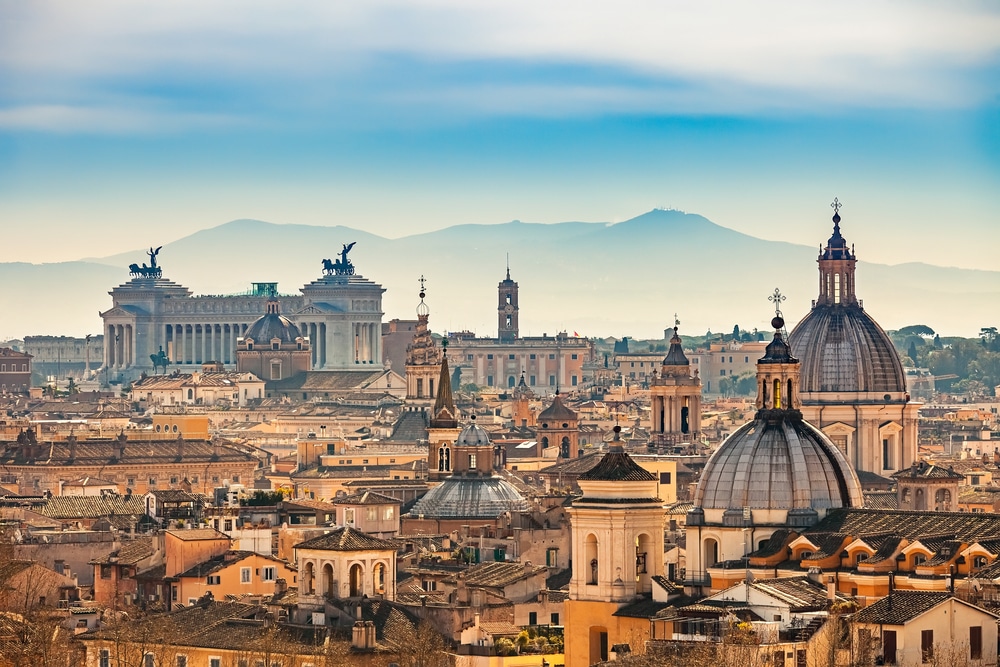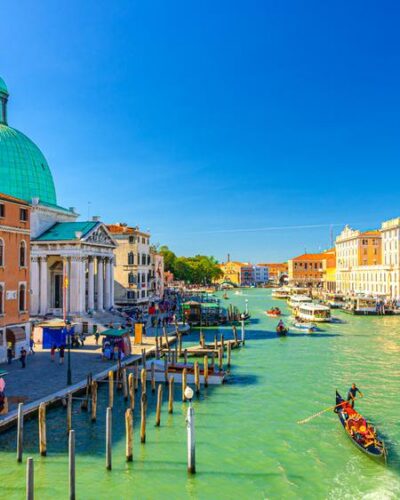Rome is one of the most visited destinations in Europe thanks to its unique and fascinating archaeological, historical, and cultural sites. There’s no shortage of attractions and places to visit in Rome, with the likes of Vatican City, the Sistine Chapel, and the Colosseum being must-see attractions.
Rome can also make an excellent base from which to explore more of Italy. As the country’s capital, it has fantastic public transport links to other major cities. Plus, its central position allows for access to popular destinations in both northern and southern Italy. In this travel guide, we’ve compiled a list of the 12 best day trips to consider during your Roman vacation.
Step Back in Time with Pompeii and Mount Vesuvius

- Distance from Rome: 150 miles
- How to get there: Train and bus
Pompeii is an ancient Roman city situated 14 miles southeast of Naples. In 79 AD, nearby Mount Vesuvius erupted and destroyed the city with volcanic debris and blistering gases.
Pompeii remained buried beneath a thick layer of ash and pumice until it was unearthed in the 1700s. The city was incredibly well preserved and offers fascinating insights into ancient Rome. In 1997, along with nearby Herculaneum and Torre Annunziata, Pompeii was designated a UNESCO World Heritage Site.
Pompeii is well worth a day trip for the chance to see ancient homes, temples, stadiums, public squares, mosaics, and wall paintings. Opt for a guided walking tour to avoid missing the key sights.
If you head all the way out to Pompeii, it makes sense to incorporate a visit to Mount Vesuvius itself. It’s an impressive sight both from its foot and its peak. The hike up is around 2.5 miles, and it’s a fairly easy trail. The ash-covered ground can be slippy underfoot, so wear suitable shoes.
Getting There
The best way to visit is via train. It takes around two hours to get there, but if you use high-speed trains, the journey is closer to 70 minutes.
There are public buses from Pompeii to Mount Vesuvius. Alternatively, you can find coach tours that depart from either Pompeii or Naples. If you’d like an organized day tour of both Pompeii and Mount Vesuvius, many depart from Naples or from Rome itself if you’d prefer to avoid the train.
Witness Exquisite Natural Beauty on the Amalfi Coast

- Distance from Rome: 175 miles
- How to get there: Car, train, bus, or boat
The Amalfi Coast is one of southern Italy’s most popular destinations thanks to its incredible natural beauty. The stretch of coastline overlooks the Tyrrhenian Sea and the Gulf of Salerno. A drive along it offers fabulous views of the sun-kissed Bay of Naples.
In 1997 the Amalfi Coast was designated a UNESCO World Heritage Site. There are 13 municipalities along its length, all of which have the trademark quaint Amalfi atmosphere. From east to west, they are:
- Vietri sul Mare
- Cetara
- Maiori
- Tramonti
- Minori
- Ravello
- Scala
- Atrani
- Amalfi
- Conca dei Marini
- Furore
- Praiano
- Positano
Positano is one of the most popular destinations on the coast, thanks to its picturesque cliffside villas. The town follows the natural incline of the mountain to create a vertical landscape.
Getting There
A popular way to see the Amalfi Coast from Rome is to hire a car and drive there. However, the journey takes around 3.5 hours each way and is daunting in places where the winding coastal road hugs the mountainside 400 feet up.
A better option is to take a fast train to Naples or Salerno, followed by a public bus or private coach tour to reach the coastline.
An alternative way to view the Amalfi Coast is by boat. Boat tours depart from the Piazza Concordia regularly in Salerno. They offer fabulous views of the rugged coastline and pretty small towns from the water below. You can also board tours from Naples.
Many full-day boat tours include stops in Positano, Ravello, and Amalfi town itself, giving you chance to explore these picturesque destinations.
Escape to Paradise on the Island of Capri

- Distance from Rome: 130 miles
- How to get there: Train and boat
The island of Capri sits in the Tyrrhenian Sea, where the beautiful coastal town of Sorrento overlooks it. The main town of Capri is famed for its limoncello, charming shops, and exquisite cafes and restaurant. The smaller town of Anacapri is home to Villa San Michele. This boasts beautiful gardens with spectacular views of Marina Grande and the rugged Amalfi coastline.
A highlight of Capri is the ruins of the magnificent Villa di Tiberio, which was built by Emperor Tiberius, who vacationed on the island. If you have time, you should also take a boat to the renowned Blue Grotto. This sea cave has a unique blue glow created by the passing of sunlight through an underwater cavity.
Getting There
It’s quite a task to get to Capri from Rome with enough time to see all the island has to offer within a day. To optimize your schedule, take a high-speed train from Rome’s Termini station to Naples, then a taxi to one of the ferry terminals in Naples. High-speed ferries depart from Molo Beverello, and these take about 40 minutes to reach Capri. Other ferries depart from Calata di Massa, but these take between 50 and 80 minutes. The whole journey takes around three hours each way.
An alternative is to book an organized day tour from Rome. These involve a coach ride to Naples followed by a boat ride to Capri. This is a convenient option if you don’t want the hassle of hopping on and off trains and taxis, but it may leave you with less freedom to explore Capri at your own pace.
Traverse the Rolling Hills of Tuscany and Florence

- Distance from Rome: 162 miles
- How to get there: Train
Tuscany is a famed region of Italy that is northwest of Rome. It is renowned for its lush green landscape, idyllic hill towns, and beautiful fields of sunflowers. The region is home to some of the best Italian attractions, including Siena, Lucca, the Leaning Tower of Pisa, and the beautiful city of Florence.
Florence is known as the birthplace of the Renaissance. It is full of architecture and artwork that exemplifies the Renaissance period.
One such example is Brunelleschi’s Duomo, which is the huge dome that crowns the magnificent Cathedral of Santa Maria del Fiore. There’s a variety of palaces, museums, and galleries to explore, with the Uffizi Gallery being particularly popular thanks to its enormous collection of art.
In Centro Storico, Florence’s old town, you can see some of the best-known Italian Renaissance masterpieces by the likes of Michelangelo, Donatello, Ghiberti, and Giotto. You can also check out Ponte Vecchio, the bridge across the Arno, which was originally built in 1218 and rebuilt in 1345 following a flood. Since then, the bridge has withstood centuries of flooding and a German invasion in World War II.
Getting There
It takes around 1.5 hours to reach Florence from Rome when you take a high-speed train. A cheaper way to get there is by bus, but this takes between 3.5 and five hours.
If you’d like to see more of the Tuscan countryside, look for a coach tour that departs from Florence and incorporates stops in some of the picturesque towns and villages that surround the city.
Discover Ancient Italian Life in Orvieto

- Distance from Rome: 75 miles
- How to get there: Train
Orvieto is a medieval town perched on a volcanic stone ridge in the region of Umbria, 75 miles north of Rome. Umbria is known as “Italy’s green heart.” It is a rich agricultural region that is sparsely populated. The hilltop town of Orvieto is a striking destination with a 14th-century Gothic cathedral at its center.
The interior and exterior of Orvieto cathedral are decorated with colorful and intricate mosaics, frescoes, stained glass, and sculptures. Inside, the Chapel of San Brizio features two exquisite frescoes by Luca Signorelli, who was an inspiration to Michelangelo.
Art enthusiasts ought to follow up their visit to the cathedral with a trip to Palazzi Papali. This is a series of medieval palaces that display Orvieto’s greatest proto-Renaissance artworks.
For insight into ancient Italian life, take a guided tour of the vast network of Etruscan-era caves, tunnels, and wells that sit beneath Orvieto’s streets. Then, go forward in time to explore the 16th-century St. Patrick’s Well, which was a feat of engineering in its day. It was built to ensure that Pope Clement VII had an adequate water supply when he took refuge in Orvieto during the Sack of Rome in 1527.
Getting There
The simplest way to visit Orvieto from Rome is by train. The journey takes just over an hour. The old town is a good uphill walk from the train station, but a funicular railway offers a convenient way to reach it.
Holiday Like a Roman Emperor in Tivoli

- Distance from Rome: 21 miles
- How to get there: Train
Tivoli is just 21 miles east of Rome, and its elevated position offers cool breezes that make it a welcome escape in the middle of summer. At the height of the Roman Empire, Tivoli was the summer destination of choice for emperors and nobility. The remains of some of these ancient summer villas, namely Villa Adriana, Villa d’Este, and Villa Gregoriana, remain today.
Villa Adriana (Hadrian’s Villa) is one of Italy’s best-preserved archaeological sites. It was built at the bottom of the Tiburtine Hills by Roman Emperor Hadrian. The vast site covered around 300 acres in its heyday. It included baths, temples, barracks, and theaters. Today, only around 100 acres are accessible, but they give a strong impression of the luxury and magnificence of the original villa.
At Villa Gregoriana, you can explore parks, woodlands, grottoes, and waterfalls. Its Great Waterfall, created by the River Aniene, is one of the most beautiful in the world. The Gregorian Bridge connects the villa with the old town center of Tivoli. It provides fantastic views of the Aniene valley and the Acropolis of Tivoli.
Getting There
Trains to Tivoli from Rome take between 45 and 75 minutes. Buses are also available, but these take an hour or more depending on traffic. Once you reach Tivoli, the main historical sites are accessible by shuttle bus or on foot.
Lose Yourself in the Renaissance in Montepulciano

- Distance from Rome: 109 miles
- How to get there: Car or train
Montepulciano is considered one of the world’s finest winemaking regions. Its position in the lush, rolling landscape of Tuscany makes it fertile and temperate enough for vineyards to thrive. The town itself is rich with Renaissance architecture and artwork.
The historic center of Montepulciano is home to Piazza Grande, a huge square framed by Renaissance palazzos. The town hall (Palazzo Comunale) has an impressive Gothic-style facade. Opposite this is a cathedral that houses a series of intricate artworks from the 15th century.
On the outskirts of the town is the Temple to the Madonna di San Biagio. Built between 1518 and 1548, it was deemed a triumph of architecture. The temple was used as inspiration for Michelangelo’s St. Peter’s Basilica in Rome.
You can’t visit Montepulciano without sampling some of the region’s wines. Vino Nobile is a red wine produced from grapes grown in the town’s surrounding vineyards. There are several wineries offering wine tasting and tours of their grounds, so you can learn more about how the wine is produced.
Getting There
It takes around 2 hours and 15 minutes to reach Montepulciano by car. Public transport is a little quicker if you take the fastest train services. Plan your route carefully if traveling by train. The slower services can take as long as 3.5 hours each way.
See the Pope’s Summer Residence in Castel Gandolfo

- Distance from Rome: 13 miles
- How to get there: Train
The small village of Castel Gandolfo sits in the Lazio region of Italy, just 13 miles from Rome. It is often known as the Pope’s City because it is home to the Pope’s summer residence. The peaceful countryside village overlooks Lake Albano and is home to a series of important historical sites.
- The Pontifical Palace was designed by Carlo Maderno and built by Pope Urban VII Barberini between 1624 and 1626.
- Church of St. Thomas of Villanova is a collegiate church in the main square that was built in 1658 for Pope Alexander VII Chigi and entrusted to Giana Lorenzo Bernini.
- Antiquarium of Villa Barberini is a series of notable art and architectural collections set within the Villa Pontificia that once belonged to the Barberini family.
- Doric Nymphaeum is an archeological site that descends from central Castel Gandolfo towards Lake Albano.
- The Emissary of Lake Albano is a long conduit that connects the west coast of Lake Albano with Mole di Castel Gandolfo.
You can also visit some of the pontifical villas when you arrange a private tour. These usually take place in small groups and require pre-booking.
Getting There
It takes around 40 minutes to reach Castel Gandolfo by train. This makes it a convenient destination for a peaceful day trip out of the Eternal City.
Taste Delicious Italian Wine in Castelli Romani

- Distance from Rome: 14 miles
- How to get there: Car or train
Castelli Romani is a region of wine-producing towns in the Alban Hills. The landscape here is volcanic, and the rich soils of the region lend themselves to agriculture. This is why vineyards are so successful here and why the ancient Romans were so attracted to the area.
The air is fresher and cooler in Castelli Romani than in central Rome. This makes the area a popular escape for many Roman locals and a great spot for a day trip for tourists.
Frascati is one of the region’s most popular towns. In summer, it is filled with outdoor diners enjoying carafes of wine. Nearby, Ariccia, a pig-farming town, is known for its local porchetta. This slow-cooked seasoned pork can be sampled in many of the towns in this region.
Marino, which is closest to Rome, produces so many grapes that one of its fountains spouts wine during its annual autumn wine festival. Nemi hosts an annual strawberry festival every summer. Tusculum is home to an ancient amphitheater which you can visit by booking a private tour.
Getting There
The Castelli Romani region is accessible by train, with journey times varying according to which town you want to visit.
A great way to explore the region is via car so that you can drop into as many towns and villages as you like. It takes about an hour to reach the area from central Rome by road.
Explore the Unique Floating City of Venice

- Distance from Rome: 365 miles
- How to get there: Train
Venice is one of the most famous cities in the world, known for its extensive network of canals. It is built on 118 small islands that are linked by bridges. There is nowhere else quite like it, and although it’s 365 miles away from Rome, for many, it’s worth a day trip.
There’s a lot to see in Venice, so study the layout of the city and plan your itinerary in advance to optimize your time. The Vaporetto, the city’s water bus system, is the cheapest way to get around. Look out for Santa Maria della Salute, a pretty Baroque church at the end of Dorsoduro.
There are many museums to see in Venice, with the Peggy Guggenheim collection being a highlight. This waterside palace houses a large collection of unique contemporary art.
Galleria Dell’Accademia is a great way to see Venice’s history via paintings. All works predate the 19th century. Highlights include Vitruvian Man by Leonardo da Vinci and The Hermit Saints by Hieronymus Bosch.
Getting There
The best way to reach Venice from Rome is by high-speed train, which takes around 3.5 hours. If you depart from Rome at 6.15 am on the Italo, you can be in Venice by 10 am.
Then, enjoy nine leisurely hours exploring the city before taking the 7 pm train home. It’s best to make this trip outside of the popular summer season to avoid wasting hours queuing for attractions and restaurants.
Learn About St. Francis in His Hometown of Assisi

- Distance from Rome: 109 miles
- How to get there: Train or car
St. Francis, the patron saint of animals, was born in Assisi. The basilica dedicated to him is one of Italy’s most important places of pilgrimage for Christians.
Construction of the church started in 1228, two years after his death, in order that his remains could be guarded. It’s a beautiful structure that combines Romanesque and Gothic styles. Subasio stone on the church’s exterior has a pink hue during the day and glows white beneath the moon at night.
Inside the Basilica of St. Francis is a range of impressive frescoes painted by medieval masters such as Giotto, Cimabue, and Pietro Lorenzetti. The most famous of these is the collection by Giotto which depicts St. Francis’ life, death, and posthumous miracles.
Assisi has a relaxed, peaceful atmosphere with lots of medieval architecture to take in. The cobblestone lanes give the town a quaint charm. It’s easy to spend a day exploring and taking in the atmosphere.
Getting There
You can drive or take a train to Assisi, with both methods taking around an hour. Going by train, you’ll get there in two hours using Alta Velocita high-speed trains. Trenitalia trains take longer and involve a stop in Foligno, a town that dates back to the 8th century and could be incorporated into your day trip.
Get a Glimpse into Ancient Rome at Ostia Antica

- Distance from Rome: 19 miles
- How to get there: Train
Ostia Antica is Rome’s former harbor and one of the best-preserved Roman cities in Italy. It was first established in the 7th century BC when it was used for trade and served as a base for the military. It steadily grew over several centuries until it became Rome’s busy commercial port serving the entire Mediterranean.
It began to silt up after being abandoned with the fall of Rome, and this silt is what preserved the city so effectively. Today, Ostia Antica is a 250-acre park with extensive excavations to explore.
A highlight of Ostia Antica is the theater of Marcus Agrippa, which is large enough to seat 3,000 people. You can also explore a wide array of houses, temples, and baths. The Forum baths were the nerve center of the city where people would gather to socialize. There are many detailed mosaics to see, which have been beautifully preserved.
Although you can wander around Ostia Antica at your own pace, a guided tour with a local archaeologist will give you a greater understanding of the city’s history. Since the site is so big, spending a full day here is easy. Note that the site is closed on Mondays, and opening hours are shorter in autumn and winter than in spring and summer.
Getting There
You can reach Ostia Antica by train. It takes just 20 minutes from the Piramide station, which you can reach on the Metro B line. Look out for a footbridge that crosses the motorway to walk from the station to the site itself.
Day Trips to Remember from Rome
Rome is a city like no other, but it’s only one of many incredible cities in beautiful Italy. Be sure to plan some day trips from Rome on your next visit to learn more about the country’s ancient history and witness its impressive landscape.
Featured Image Credit: S.Borisov













